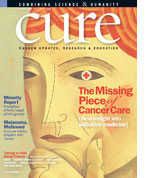Long-Distance Lifesavers
Resources and tips for long-distance caregivers.
Caring for a faraway loved one requires a lot of resources and a heap of ingenuity. Here are some ways to reach out, gleaned from experts and clever caregivers.
> A web planning service Lotsa Helping Hands (www.lotsahelpinghands.com) earns kudos for allowing both local and distant caregivers to coordinate efforts and share thoughts. Other online options include Caring Bridge (www.caringbridge.org) and Share the Care (www.sharethecare.org).
> Cell phone If the cancer patient does not have one, now may be the time for a surprise gift. Jitterbug offers a cell phone and services designed specifically for senior citizens (www.greatcall.com).
> E-mail blasts, blogs, and websites dedicated to the patient Sure, a great way to communicate, but some cancer patients prefer privacy over electronic fame. RedToeNail.org allows users to set up a secure blog. There are other blog hosting sites, such as Wordpress.org and Blogger.com, that offer privacy settings, allowing the blogger to control who can see the blog.
> Lifeline For a frail patient, the monthly fee provides a buzzer to press in case of emergency. A special telephone for reminders to take pills is extra.
> Meals and other services Home delivery services, such as Meals On Wheels Association of America (www.mowaa.org), can ensure the patient receives healthy meals. Typically, special requirements must be met for meal services provided by nonprofits, so make sure to do your research. Grocery delivery and transportation services are also available. The American Cancer Society’s Road to Recovery provides transportation to and from treatment in communities where resources are available, and can be arranged by calling 800-ACS-2345.
> A video camera on the patient’s computer and a caregiver’s computer You can eat dinner together! If you can figure out how to install. (A geek squad can fill in for technophobes.)
> Stay one step ahead The National Institute on Aging’s So Far Away: Twenty Questions for Long-Distance Caregivers provides direction for the unique issues that come up along the way (www.nia.nih.gov).
> Gift cards This may seem like a more elegant way of offering support than sending a check. Try gift cards for pharmacies (to cover pill co-pays) or grocery stores.
> Pre-stamped, pre-addressed postcards for the younger generation There’s nothing like a tangible sign of love, written by a grandchild, niece, or nephew.
